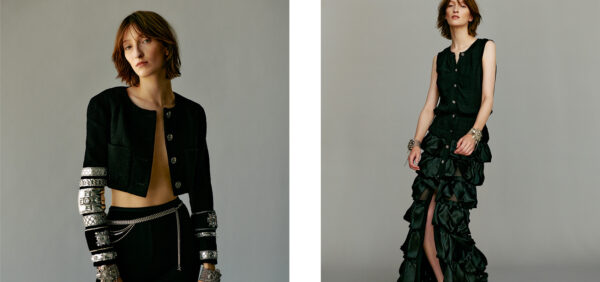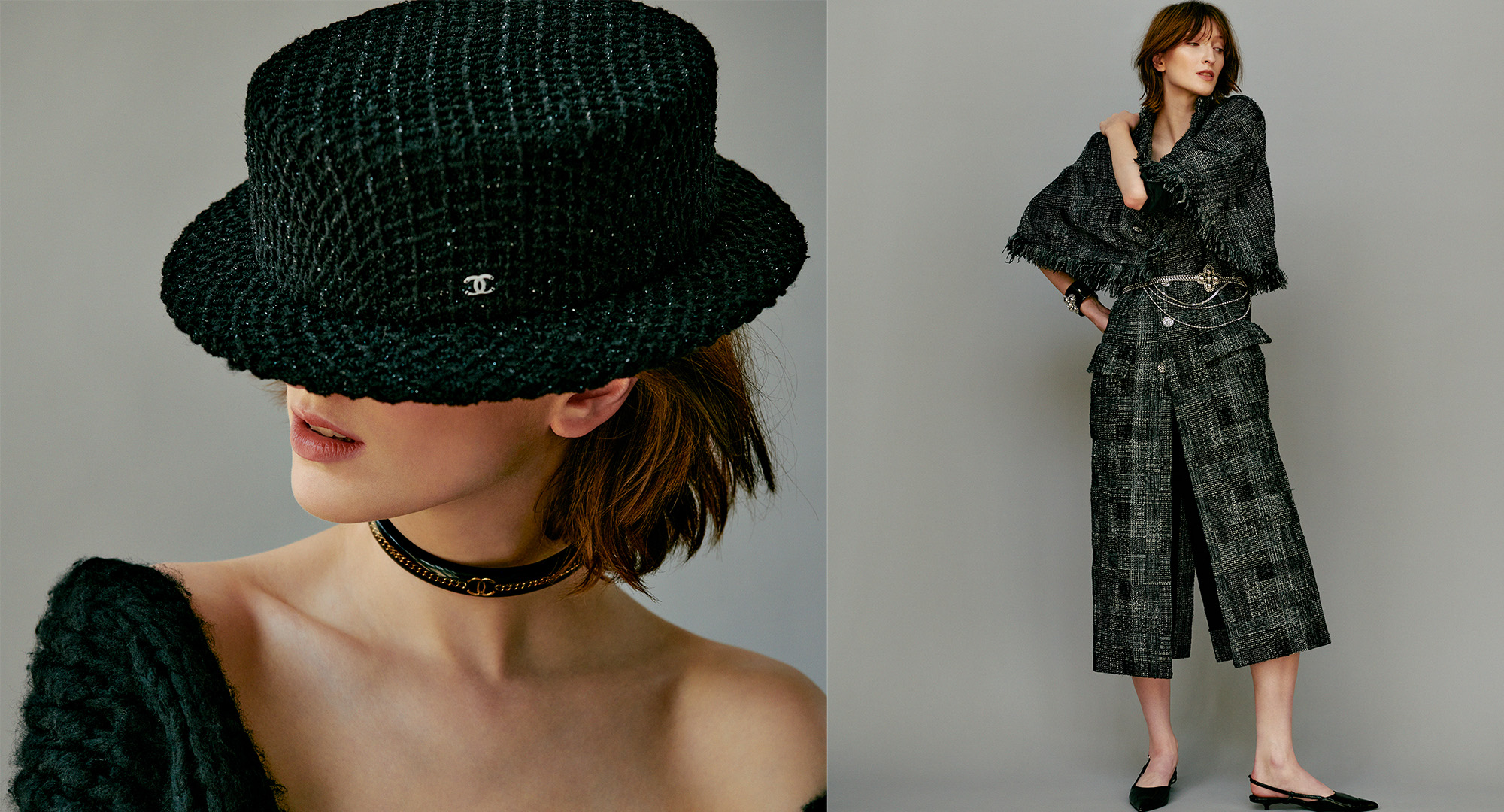le19M is home to a constellation of unparalleled ateliers practicing the most complex and intricate techniques of French craftsmanship in the world.
The name is simple enough: le19M: ‘M’ for Métiers d’art, mode, main, maison et manufacture (craft, fashion, hand, fashion house and manufacturing, in French) and ‘19’ for its location in the 19th arrondissement, the northeast corner of Paris. It is also the date of Chanel founder Gabrielle Chanel’s birth, in August of 1883.
However, despite its unassuming name, le19M is home to a constellation of unparalleled ateliers practicing the most complex and intricate techniques of French craftsmanship in the world. Consider, from the Chanel archives for Couture Spring 2016, a suit jacket with oval sleeves that took 2,500 hours and 435,000 wooden beads to create, with 55 hours of stitching needed to create the folds of a matching skirt; a feathered, Ancient-Egypt-inspired dress from the Métiers d’Art 2018 show that needed more than 1,000 hours of work for each plume to be hand-painted and glued exactingly to form spectacular patterns and, in the latest 2021/22 Métiers d’Art collection, a fully embroidered crochet sequin dress that required 530 hours of work, or a top made with crochet and needlework that took around 400 hours of work in a pattern inspired by the le19M architecture structure.
The structure, a triangular, seven-level, 25,000 sq m glass, iron and concrete building, possesses a Cinderella-esque magic where coquis (sketches) are spun into couture. An interior 2,600 sq m courtyard buzzes with beehives, Japanese cherry trees and Gabrielle Chanel’s beloved camellias. The structure was designed to group the majority of Chanel’s Métiers d’Art, or specialist crafts vocations, in a single place: expert embroiderers, feather makers, boot and glove makers and suppliers of plissé fabrics, pearls et al, to couture and high-end ready-to-wear houses, some 600 employees across 25 different companies in total. Among those include Lesage and its embroidery arts school (Lesage creates Chanel’s iconic tweed embroidery), the Montex atelier and its decoration department, shoemaker Massaro, feather and flower expert Lemarié (responsible for the signature camellia on every Chanel product), flou specialist Paloma, button maker Desrues, costume jewelry makers Goossens, milliner Maison Michel, pleater Lognon, textile weavers ACT 3, leathersmith Ateliers de Verneuil-en-Halatte, cashmere specialist Barrie, and expert goldsmiths, tanners and leatherworkers—all working directly with the Chanel creation studio, while also providing a hub of craftsmanship and creativity for other fashion houses, (commissions from other couture houses include Dior, Valentino and Balenciaga, and ready-to-wear for houses like Louis Vuitton, Fendi and Lacoste as well as independents such as Alexandre Vauthier and Christopher Kane). The Chanel-owned lingerie and swimwear brand Eres is also headquartered in the building, despite not being part of the Métiers d’Art group.
It is in these halls that ancient artisanal techniques and the savoir-faire required to realize them are passed from the older generation to the new in an act of preservation of historic French culture—and an undeniable devotion.
“This building is a tribute to Chanel’s craftsmanship, it is designed for the glory of the people who work for Chanel,” explained the building’s architect, Rudy Ricciotti, also designed the department of Islamic arts at the Louvre, the MuCEM in Marseille, the Jean Cocteau museum on the Riviera and the Peace Bridge in Seoul, South Korea. The architect paid homage to the craft of the workers within his structure by wrapping the glass building in concrete threads, recalling the textiles created within.

Black georgette crepe dress, silver cuffs and black pumps. All by Chanel.
The reverence between Chanel and the Métiers d’Arts goes back to Gabrielle Chanel herself who began working with footwear manufacturer Massaro to produce the iconic two-tone shoe, the signature feathers and camellias by Lemarié, signature buttons created by Desrues (the first craft company to be acquired by Chanel under the direction of Karl Lagerfeld in 1985), and Goossens to realize her costume jewelry. Then, Chanel began to acquire these companies to ensure their endurance, supporting the development and training of new artisans. In 2002, Karl Lagerfeld presented the first Chanel Métiers d’Art show, a mix of ready-to-wear and haute couture, that continues bi-annually to this day, to exalt the unique expertise of the craftspeople and cast a spotlight upon their work within le19M.
At the building’s unveiling in October 2019, Bruno Pavlovsky, president of Chanel Fashion and president of Chanel SAS, described le19M as “an open house, a place of meeting diversity… A center where artisans, the public, schools and students and lovers of art in the neighborhood can meet.”
Here, Mission takes the opportunity to meet some of le19M’s brightest talents, who describe in their own words their love of their craft.
Yaya Ouattara, Pleater, Lognon
It was thanks to the Mode Estime association that I arrived at 19M in October 2021. Lognon was looking for pleaters and Mode Estime contacted me to apply. I liked the artisanal aspect of manual pleating and the possibilities offered by mechanical pleating. [In the future] I would like to know how to do everything in the stages of creatinga pleat: from making looms to pleating complex patterns.
Vivien Dillensiger, Pleater, Lemarié
I started by temping at Lognon in May 2021 after professional retraining and have worked in several houses. What I like about pleating is that the result is almost instantaneous. It gives another dimension to the material. I am now at Lemarié and I hope that in five years I will have evolved within the Lemarié house and that I will have been able to test several of the trades there, to be able to do extraordinary things with my hands.
Julie Bastart, Feather maker, Lemarié
I started out as a costume designer. When I discovered the know-how of the Lemarié house, it was a revelation—true love. To be able to transform and work the raw material with such meticulousness, I was completely smitten. Now, I have been working for the Lemarié house for 14 years. During the creation of the 19M project, it was [wonderful] to discover this new place, which brings together all the know-how in brighter and more spacious workspaces. One of the highlights of 19M was the arts and crafts parade on our own premises. Being able to live and be part of the world of a fashion show is very rewarding and seeing our models finished and in motion is a source of pride.

Noémi Crosetti, Milliner, Maison Michel
I joined Maison Michel as an apprentice in November 2019, 18 months before the house moved to 19M last year. There is no real typical day at work. Every day there are new projects, each different from the last. But generally, I can sew straw assemblies, trim hats and cut sewn or stretched fabrics; it varies depending on the project. I like working on new projects and the fact that the work changes all the time; there are always new things to do, which makes this work rewarding and it’s also very pleasant in the new premises at 19M.
Louise Maillard, Textiledesigner, Lesage
I joined the textile team at Lesage a year ago through a six-month internship where I was able to assist textile designers in the development of tweeds. During this experience, I was able to participate in the development of eco-responsible textiles. The projects entrusted to me during my internship as well as these new creative perspectives really intrigued me. I then proposed to continue my adventure with Lesage in the form of a two-year master’s degree, on a work-study basis, on eco-responsibility in the fashion ecosystem. I have been working for six months as a junior textile designer and am training in parallel on the function and communication of eco-responsibility in fashion and textiles, the sourcing of responsible materials and labels and certifications. What I like about textile design is the possibility of bringing together several skills in a single creation. I kind of see the loom as an extension of myself, a way to express my creativity, to convey emotions and messages.
Marie-Anna Giacomini, Assembly/finishing ateliermanager, Goossens
I studied fashion design for three years, after which I trained directly on the job in the DCP (Delphine-Charlotte Parmentier) atelier for my end-of-studies internship and stayed for a total of seven years, evolving little by little, taking on more and more, ending up as atelier manager of assembly, resin and rhinestones. Then, I had the opportunity to join Goossens a year ago as head of the finishing atelier. In five years’ time, I still see myself at Goossens. I like to pass on the knowledge and techniques and hope to continue to grow the team. Otherwise, I could see myself returning to Corsica, my hometown, and completely change paths and become a florist!
Victoria Fuchs, Cornely embroiderer, Montex
The Montex atelier is one of the last ateliers to perpetuate its particular know-how. I’ve been at the Montex atelier for four years, during the first two on a work-study contract, where I was able to train in the Cornely embroidery technique. I was subsequently employed on a permanent contract as a Cornely embroiderer. One of the designs on which I spent more than 30 hours was a jacket for the Chanel Métiers d’Art 2021 collection, which was presented at 19M. I really liked working on this model, the material was very fragile, which required all the more precision and delicacy.

Black wool jacket with embellished pockets, silver chain belt, and beige and dark grey pumps, all by Chanel.
Julie Doberset, Pattern making and stitching, Massaro
I started to work at 19M in March 2021. I was so excited about the 19M project and it is one of the reasons I applied to Massaro. It is very important for me to transfer know-how to the next generation and we hire new apprentices every year. In fact, when I decided to do this job, I realized how hard it was to learn how to make shoes. The footwear industry has disappeared in France and, as a result, there are only a few institutes today. For that I decided to leave France for Italy where all the luxury shoes are made, to learn this expertise with the best craftsmen. Now I want to share what I learned there with the next generation of Maison Massaro. The best thing at 19M is [that we] work on totally different projects every day and collaborate with the other Maisons d’Arts. For example, in one week, I can design a sneaker for a gamer, work on elegant boots with embroideries in collaboration with Montex, or make the pattern for a pair of orthopedic shoes. We learn new things every day and I am really passionate about my job.
In this story: Photography by Christophe Meimoun. Styling by Gro Curtis. Hair: Javier Palacio at Capsule Agency. Makeup: Tina Roivainen at Airport Agency. Model: Grace Sharp at Models One. Photo assistant: Morgane Pouliquen.
In partnership with Chanel. chanel.com from Mission’s United Nations issue.





